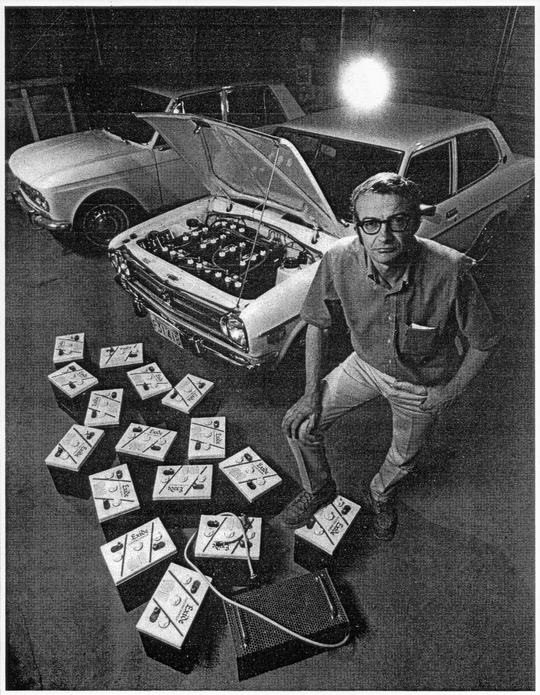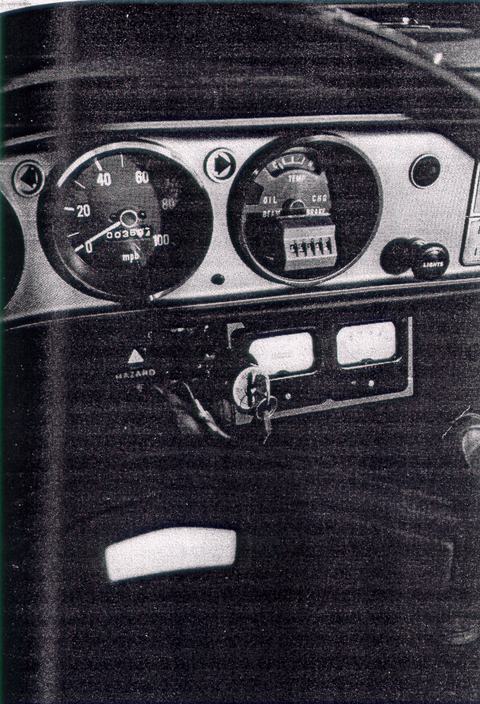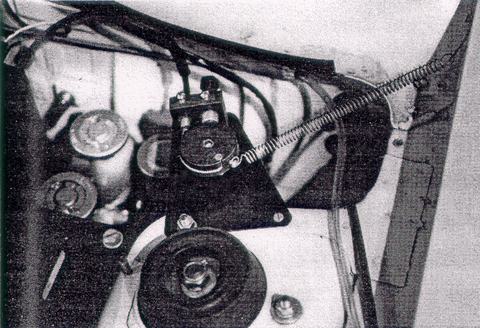Magazine article Car and Driver October 1973 pages 72-75
Fullfillment at last for those seeking a modern-day Baker
NOTE: Baker Motor Vehicleᵂ had the most popular automobile prior to World War I. The Baker was a battery electric vehicle.
Contents |
Page 72
ATHOL'S ANSWER TO THE ENERGY CRISIS
BY DON SHERMAN
Fullfillment at last for those seeking a modern-day Baker
Meet Chandler H. Waterman—self-made czar of America's electric automobile industry. For the past eighteen months, he has offered the public an alternative to fuel shortage. Instead of lining up at the gas pumps for a ration of petroleum, his customers simply plug their cards into a wall socket at night. The shortage of crude oil could be in Siberia instead of the U.S. as far as Waterman and his followers are concerned. Their automotive sustenance flows out of a wire instead of a hose. As long as clocks and refrigerators keep running, the CHW electric car has ready access to all the energy it needs.
CHW Industries is no mushrooming megalofirm that will revolutionize our energy needs overnight. Instead, Waterman is essentially a one-man company. He is president, chief engineer and car fabricator, as well as sales manager His duties extend to sweeping the floor, but he is proud of the origin of it all.
A high school physics class unveiled to Waterman his guiding light. There, electricity and magnetism experiments grabbed his fascination with a crab-like grip that has not slackened in the last twenty years. Confronted by the need for a wage-earning skill, Waterman automatically drifted toward electronics and electro-mechanical devices. Within that context, he rose to Project Engineer status at Simplex Time Recorder, but it was not to be for long. That same physics class also revealed the amazing fact that it takes but 15 horsepower to move a conventional automobile down the road at a steady 40 miles per hour. With that salient piece of information imprinted in his memory bank, there would be no mental tranquility for Chandler H. Waterman until his car moved down the road at 40 mph—powered by the magic flow of electricity.
Why should his mouth water at the sound of a humming electric motor? Waterman says that electricity always seemed more efficient to him; a simpler, purer, more direct form of energy. It's been that way since high school. While his friends were aroused at the rumble of blown-out mufflers, Waterman fantasized the day when he would purr softly down the avenues in his electromobile.
For years those thoughts trickled through his mind but came no closer to physical embodiment. Until 1968, that is, when prosperity and a 1967 Datsun in the driveway provided the proper setting for those high school experiments to continue. After some perfunctory calculations to estimate the hardware needed for the job, Waterman plucked the seething, shaking gasoline engine from its bay. And into those yawning confines, he mounted a brace of batteries and a surplus electric motor.
Even that primordial Datsun was a success in electric car terms because it worked as expected from the first turn of a wheel. And that is due as much to Watermans's personality as it is to his genius. He is the very antithesis of the Mad Scientist image. Every hair on his head is neatly in place. He wears heavy black-rimmed glasses that lend a certain scholarly refinement but not the air of an unbelievable intellectual. And his words are those of a man with his feet on the ground. Waterman will tell anyone that a high school kid could duplicate the technology in his car. That is but a small exaggeration. Still, Waterman knows it is they key principle allowing him to be a car manufacturer with microscopic means.
And microscopic they are. Waterman is a handy man. He built his own house overlooking a lake, shielded from civilization by a one-mile periphery of trees. And when his electric experiments bore fruit he built his own "factory". It's an overgrown two-bay garage with some extra storage space. In place of the monstrous stamping presses, transfer lines and tape-controlled milling machines that dominate most car factories, there's nothing but a few shiny hand tools. Waterman does use a table saw to cut out the Benelex 401 material he uses as an adapter plate between the motor and transmission. A Detroit engineer would without hesitation specify steel or aluminum for that application, but Waterman chose the masonite-like Benelex because it does the job and can be fabricated on much simpler machinery. You can easily hold all the battery and motor mounting brackets for the CHW Electric car in one hand. Waterman, or one of his two regular employees, cuts them out of hardware-store angle iron and bends them to shape on a homemade press. In the few places where welding is necessary, it's done with acetylene because an arc welder is still beyond the means of Chandler H. Waterman Industries.
In every way, the car benefits from simplicity. There's not a single transistor in the speed controller (see sidebar) to fail at some inopportune time. Any mechanic
| 72 | CAR and DRIVER |
Page 73
Page 74
familiar with a conventional starter motor can easily repair the CHW electrical system. The batteries are standard golf cart or fork lift units available off the shelf in any large city. And the non-electrical portion of the car falls under a Datsun new-car warranty. CHW Industries does not yet benefit from a sea of technicians and a NASA-like test program. For that reason, Waterman sends his cars out the door only with the simplest parts that have, in other applications, proven themselves as reliable as an anvil. He talks of solid state controllers and NiCad batteries, but always with the preface that they are far in the future. Today is most important to Waterman. He sees CHW Industries as an infantile effort to offer electric cars during the interim period before they become genuine consumer disposables. He's convinced that some sprawling corporation like General Motors or Westinghouse will one day roll an electric car off the assembly line, probably within ten years. When that happens, Waterman's miniature effort will either be blown off the map by mega-buck progress or soaked up into the spongy comfort of capital mergers. If he pumps a few hundred cars onto the road before that day of reckoning, Waterman will at least have a very firm base of negotiation. Right now, there are 23 customer cars whining down the road with a CHW decal on their door sills. Seven dealers are on hand to do business, all located in the Northeast U.S., close to Waterman and his Athol, Massachusettsᵂ factory. The bulk of inquiries flow in from pollution-conscious California, but as of yet, a remote assembly point is not justified. Instead, Waterman feels his influence must grow gradually until there are 100 satisfied customers to refer to. He's recently cut the price by $875 (his profit) just to encourage a quicker flow out the door and into his net receivable's column. Now you can buy his Model 906, converted from a Datsun 1200 sedan, for $3995, complete with portable charger. Waterman seriously believes there has to be a few thousand atypical individuals in the U.S. who would trade in their gasoline credit cards for a utility bill. Electric cars are certainly on the lips of the vociferous ecological alarmists. As a result, energy awareness has penetrated every household, so the time is ripe for a virtuous alternative. But Energy Crisis considerations alone will not sell the car. Waterman knows that, in the foreseeable future, at least, his customers must have electricity instead of blood flowing through their veins.  Nine batteries under the hood, eight more in the trunk |
How the CHW works is pure simplicity itself—nine batteries under the hood, eight more in the trunk, a block that keeps you from shifting into fourth and an accelerator that gives four speeds—all slow It starts with the same key that brought the Datsun's original gasoline engine to life. You turn the switch briefly to the "Start" position and a set of relays click under the hood to prepare the dammed-up kilowatts to work. But until you're ready to move away, there's nothign but heavy silence—and no power drain whatsoever. Put the standard Datsun 4-speed shifter in second for level surfaces, or first whenever a "super-low" is necessary. And then you just step down on the accelerator to motor off into tomorrow. The standard clutch is there, but only for shifting once you're underway. Ever-present is the varying whine of the electric motor—the sound you'd expect to hear from a slow spinning turbine. The crescendo peaks at the car's top speed (45 mph) where the intrusion amounts to 77.5 dBA. That's the same interior level as in an Audi 100LS cruising at 70 mph. Electro-advocates to the contrary, the day of silent propulsion has not yet dawned—at least not in Athol, Massachusetts. To accelerate, you simply mash down the accelerator into one of four different heavily-detented positions. That connects, through relays, either 12, 24, 36 or 48 volts to the compound-wound, 18-horsepower DC motor. Immediately before you are two meters to relate what's going on in your mobile power station. One is a voltmeter for an indication of the batteries' charge state and the other is a conventioinal ammeter. It registers exactly how much energy you're withdrawing from the saving bank at any given time—which affect the ultimate range on the present charge. In the owner's manual, Chandler Waterman recommends not exceeding half scale or 500 amps for extended periods.
 Speed is controlled by selecting different voltages |
| 74 | CAR and DRIVER |
Page 75
| OCTOBER 1973 | 75 |

![[Datsun 1200 encyclopedia]](/wiki/upload/wiki.png)


